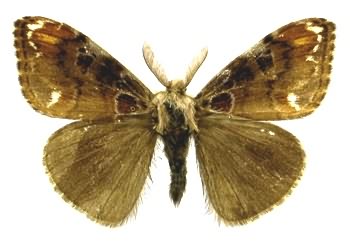Pests
Orgya recens (Hbn.) - Scarce Vapourer.
Systematic position.
Class Insecta, order Lepidoptera, family Lymantriidae, genus Orgyia. The subspecies O. r. approximans (Butl.) is recognized in the Far East.Biological group.
It is a polyphagous pest of fruit crops and forest trees.Synonyms.
Orgyia gonostigma (Linnaeus, nec Scopoli), Teia recens (Hbn.), Telochurus recens (Hbn.).Morphology and biology.
Sexual dimorphism is strongly pronounced among this species. Male has comb-like antennae; forewing coffee-brown, with distinct pattern of dark and light bands and light ocher-brown stroke at tip (wingspan to 25-32 mm). Female has hardly visible reduced wings, with thick abdomen covered with rich short dark gray or yellowish silky setae. Short antennae very thin, with short crista; legs well developed. Eggs are mat-white, weakly shining, somewhat flattened, with shallow depression at top. Caterpillar has black warts on back and on each side and with bunches of setae of different lengths. Male pupa is oblong, female pupa fusiform. Pupae light brown, covered with sparse yellow silky setae. Females fly in the afternoon in first half of July (within the zone of one generation), or from the second half of May to mid-June, then in August-September (within the zone of 2 generations). Non-flying females usually sit awaiting males on the surface of their cocoons, where the mating occurs. Fertility is 150-300 eggs on the average, 2000 ones maximum. Female is slow-moving; it lays eggs in one multi-layered batch on the surface of its cocoon, covering eggs with abdominal scales and hairs. Eggs develop over 14-20 days. Caterpillars hatch from the last third of July and the beginning of August (within the zone of one generation), in June-July, then at the end of August-in September (within the zone of 2 generations). Pupation occurs during the second half of June (within the zone of one generation), or in the first half of May and the middle third of July (within the zone of 2 generations). Pupae develop over 20-25 days in the zone of one generation; or 11-14 (1st generation) and 6-7 days (2nd generation). During the 3rd-4th instar (within the zone of one generation) or 2nd-3rd (within the zone of 2 generations) the caterpillars winter, locating themselves separately in silky cocoons among vegetation residues.Distribution.
The species is distribution throughout Western Europe (except for Far North), Northern Iran, Mongolia, China, Korea, Japan, Baltic States, Byelorussia, Ukraine, Moldova, Transcaucasia. In Russia it is distributed throughout the entire European part (everywhere southward of the line of Petrozavodsk-Perm), in South Ural, North Kazakhstan, Southern Siberia (the south of forest zone and forest-steppe one), Transbaikalia, in the Far East (Amur Region, Khabarovsk and Primorskii Territories) and Southern Sakhalin).Ecology.
It is monovoltine in the north of its area and in Siberia, bivoltine in other regions. Some caterpillars give a 2nd generation within the zone of one generation when temperatures are higher than the mean annual norm. Caterpillars are most harmful during the spring period. The young caterpillars hanging down by their threads are carried by wind for a long distance. In the zone of one generation, the resumption of feeding by caterpillars begins in the beginning of May at temperatures of 6-12° C. In the zone two generations the caterpillars feed starting in mid-April and in August-September. Young caterpillars of the 1st generation eat buds, later they eat leaves, destroying them entirely. Caterpillars of the 2nd generation eat the pulp of leaves, gnawing out holes and gnawing them round along margins. The pest population density is regulated by numerous parasites.Economic significance.
These Polyphagous caterpillars damage fruit crops (apple, pear, plum), and also hawthorn, raspberry, strawberry, currant, gooseberry, etc. In forests and parks they feed locally on wild-growing rosaceous and deciduous trees, such as hazel, alder, birch, oak; they cause harm to larch. Low damage is recorded on soy. Target treatments are not practiced. Local insecticide treatments during caterpillar hatching and mating by use of synthetic sex pheromones are recommended during mass outbreaks.Reference citations:
Chistyakov Yu.A. 2003. Lymantriidae. In: Ler P.A., ed. Keys to the insects if the Russian Far East. V. 5(4). Trichoptera and Lepidoptera. Vladivostok: Dal.nauka. 603-631 p. (In Russian)Kozhanchikov V.V. 1950. Orgyidae. In: Pavlovskii E.N., Shtakel.berg A.A., eds. Fauna of the USSR. Lepidoptera. V. 12. Moscow-Leningrad: AN SSSR. 581 p. (In Russian)
Kuznetsov V.I. 1999. Lymantriidae (Liparidae, Orgyidae). In: Kuznetsov V.I., ed. Insects and mites - pests of agricultural plants. V. 3(2). Lepidoptera. St. Petersburg: Nauka. 279-320 p. (In Russian)
Nekrutenko Yu.P. 1974. Lymantriidae. In: Vasil.ev V.P., ed. Pests of agricultural crops and forest plantations. V. 2. Arthropods. Kiev: Urozhai. 357-361 p. (In Russian)
Prokof.ev M.A. 1987. Siberian orchards protection against pests. Moscow: Rossel.khozizdat. 239 p. (In Russian)
Vasil.ev V.P., Livshits I.Z. 1984. Pests of fruit crops. Moscow: Kolos. 399 p. (In Russian)
Vorontsov A.I. 1982. Forest entomology. Moscow: Vysshaya shkola. 384 p. (In Russian)


